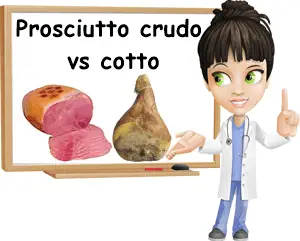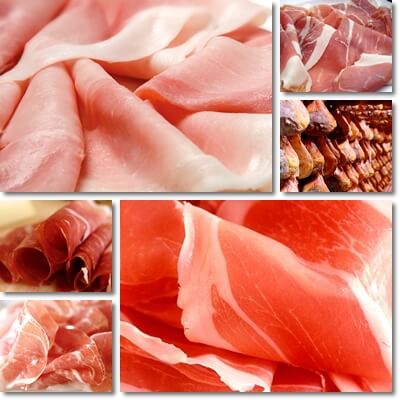What is the difference between prosciutto crudo and prosciutto cotto? The biggest difference between the two types of prosciutto is in the name: prosciutto crudo is raw, uncooked ham (crudo, that is), while prosciutto cotto is cooked ham (cotto, that is). Prosciutto crudo is salt-cured, air-dried and aged for 12-13 months and up to 2-3 years, whereas prosciutto cotto is cured by immersion in a brine solution, then steam-cooked, which takes only several hours. Read on to find out more helpful information about the differences between between prosciutto crudo vs cotto.
Difference 1: type
The simplest, most obvious difference between prosciutto crudo and cotto is in the name: prosciutto crudo is raw or uncooked ham (crudo in Italian), whereas prosciutto cotto is cooked ham (cotto). However, prosciutto crudo isn’t actually raw meat in the sense that, while uncooked, it is cured and aged. Salt-curing and air-drying for months to years ages the meat, processing it so that it’s rendered safe to eat even without cooking.

Difference 2: processing
Both prosciutto crudo and cotto are cured ham products, but the curing process differs. When making prosciutto crudo, the back pig leg is salted (and seasoned) and allowed to rest so that the blood and other juices in it drain, then salted again before being hung to dry in a cool, well-ventilated room. There are several cycles of salting to achieve the specific flavors of the prized Italian ham and prevent spoilage since there is no cooking involved.
Most of the prosciutto crudo retains the pork skin, except for the part opposite to the pig’s foot, where the meat is exposed to air. To protect it, a greasy mix of pork lard, salt, pepper and often other spices, herbs and ingredients (such as finely ground rice or other grains) is applied. This forms a protective coating that protects the ham during the curing process.
Prosciutto cotto is salt-cured and then steam-cooked. Prosciutto cotto is usually cured by immersion in a brine solution, vs crudo which is simply salted. Cooking time varies according to the size (weight) of the ham, lasting anywhere from a few hours to a whole day. Versus prosciutto crudo which is salt-cured to drain moisture and hung to air-dry and age, prosciutto cotto is pressed to give the ham its dense, compact consistency.
Difference 3: appearance
Prosciutto crudo is a large block of cured ham, with a weight of at least 7.5 – 8.5 kg (a requirement for DOP prosciutto). It is made entirely from pig’s back leg, with the actual ham being the upper part of the pig’s back leg, that is, the thigh. The meat is different shades of pink-red and red with thin, white veins of pork fat running throughout, giving it a marbled design, and a thicker, white band of fat near the rind. DOP prosciutto crudo is usually thinner at the end with the pig’s foot, with little to no ham, and thick and bulky and meaty at the end with the pig’s thigh. Some DOP prosciutto crudo even retain the pig feet (e.g. prosciutto di San Daniele).
The rind is tan and marked with the logo and name of the ham, which usually coincides with the place of production in the case of DOP prosciutto (e.g. prosciutto di Parma, prosciutto di San Daniele, prosciutto di Modena, prosciutto di Toscano). Numeric identifiers such as the year when the production of said specialty began or the date indicating the start of the curing process may also be present on the rind, all fire branded.
Prosciutto cotto is a large boneless ham, typically round-shaped or rectangular with rounded corners. Inside, the cooked ham is different shades of pink with thin, white veins of fat that give it a marbled effect. There is also a thicker band of white pork fat near the rind. The rind is tan and typically fire branded with the name of the ham and place of production (which are usually the same for certified traditional Italian prosciutto), a logo and sometimes also a date, usually the year when the production of said specialty began or the start of the curing process.

Difference 4: taste
The taste of prosciutto is determined by the processing undergone. There are significant differences in taste between prosciutto crudo and cotto, and even between the different varieties of prosciutto crudo. For the most part, prosciutto crudo is compact and dense, slightly stringy, and the tender meat easily breaks into fine strips. It’s so tender that the meat tastes almost buttery giving the impression that it melts in your mouth. The taste is characterized by rich, aged pork flavors that vary according to the type of prosciutto – some varieties of prosciutto have sweet-flavors, while others a nutty taste. If you cook prosciutto crudo slices in a pan, the meat becomes crisp and even brittle and, as the slices lose moisture, the taste turns salty. By comparison, prosciutto cotto is soft and tender, with a delicate and light cooked pork taste, much less pronounced than prosciutto crudo.
Note: Vs prosciutto cotto which is already cooked, prosciutto crudo is uncooked, but perfectly edible as it is. While you don’t need to cook prosciutto crudo to render it edible or safe to eat, you can, but know that cooking will alter its taste and texture, causing the slices of ham to become salty and brittle.
Difference 5: certification
Prosciutto crudo di Parma, San Daniele, Modena, Toscano, Carpegna, Cuneo, Veneto Berico-Euganeo and Vallée d’Aoste Jambon de Bosses are the main types of prosciutto crudo with PDO (or DOP) certification. PDO means Protected Designation of Origin (DOP, Denominazione di origine protetta, in Italian) and it’s an internationally recognized certification under EU law. It means these types of prosciutto are traditional agricultural food products from specific regions of Italy, produced according to set standards, and time-honored traditional recipes, and from high-quality materials, without the addition of food additives of any kind.
Other types of prosciutto crudo, such as prosciutto di Norcia or prosciutto di Sauris, have a PGI certification, meaning Protected Geographical Indication (IGP, Indicazione geografica protetta, in Italian), also recognized under EU law. Prosciutto di Venticano, prosciutto di Trevico and many other crudo varieties are recognized in Italy as traditional Italian regional food products with the logo PAT, meaning Prodotto agroalimentare tradizionale. Versus prosciutto crudo which boasts multiple certifications, prosciutto cotto doesn’t, although it’s still an internationally recognized ham, even without the certifications. Some of the most famous prosciutto crudo producers also make cotto versions of their famous aged ham products.
